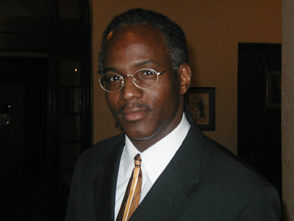Herman Atkins

Herman Atkins in 2002. (Photo: Jennifer Linzer)
Wanted poster led to misidentification and conviction
Convicted in 1988 of the sexual assault and robbery of an employee of a shoe store in Riverside County, California, Herman Atkins was exonerated by DNA and released in 2000.
On the morning of April 8, 1986, a thin, young African-American man wearing a dark jacket, Reebok shoes, and a gold ring entered a shoe store in the town of Lake Elsinore. After looking at some merchandise, the man, who was the only customer in the store, pulled a handgun and forced the twenty-three-year-old clerk, who was white, into a back room. He threatened to kill her, forced her to perform oral sex, and then fled, taking $130 in cash from the store, her engagement ring, and another ring.
She was examined at a local hospital, where her sweater was preserved as evidence. Then she went to the police station where she noticed a wanted poster for a twenty-year-old man being sought for wounding three persons, including two police officers, in South-Central Los Angeles the previous January 26. The man was Atkins, who apparently had fired shots at someone who was robbing a friend of his, accidentally striking the officers.
From the poster, the victim identified Atkins as the man who raped her. She later identified him from a photo spread featuring the same photo. After his arrest in October 1986, she identified him as he sat in a courtroom with six other prisoners, all of whom were white. He also was identified, first from the wanted poster and then in the courtroom, by a witness who claimed to have seen him in a nearby store shortly before the crime. While being held on the shooting charges, to which he would plead no contest and accept an eight-year sentence in Los Angeles County, Atkins was charged with the Lake Elsinore crime in Riverside County.
At his 1988 jury trial, the lead prosecutor, Richard Bentley, relied primarily on the identification by the victim and the employee of the neighboring store. In addition, Bentley called James Hall, a state crime laboratory serologist. Hall testified that he had tested a stain containing a combination of semen and saliva on the victim's sweater and found genetic markers shared by only 4.4 percent of the population. However, Atkins and the victim both happened to fall into that group. Thus, Hall acknowledged, the victim alone could have accounted for the markers, but Bentley told the jury, "So, the evidence can't be used to say this is exactly him, but it excludes a large percentage of the people, and does not exclude him, and that's corroboration."
Atkins took the stand in his own defense, claiming he had never been to Lake Elsinore, about an hours' drive from Los Angeles. His wife testified as an alibi witness, swearing that he had been in Los Angeles at the time of the crime and did not have access to a car.
The jury returned a verdict of guilty and Atkins was sentenced to forty-seven years and eight months in prison. He filed a series of pro se appeals, but each was denied without a published opinion, the last in 1992. The following year, the Innocence Project of the Cardozo School of Law in New York agreed to seek DNA testing of the victim's sweater. It took four years to obtain a hearing on a motion to release the sweater for testing, but then a local lawyer working with the Innocence Project failed to appear at the hearing and the motion was denied. It was not until 1999 that the Innocence Project finally secured release of the sweater for testing by Forensic Science Associates of Richmond, California, which positively excluded Atkins as the source of the semen.
After the accuracy of the tests was confirmed by the FBI crime laboratory, the prosecution moved to vacate the conviction and Atkins was released on February 18, 2000. He filed a federal suit for violation of his civil rights seeking $10 million in compensation. That case was still pending in early 2006.
— Elizabeth Kirk

